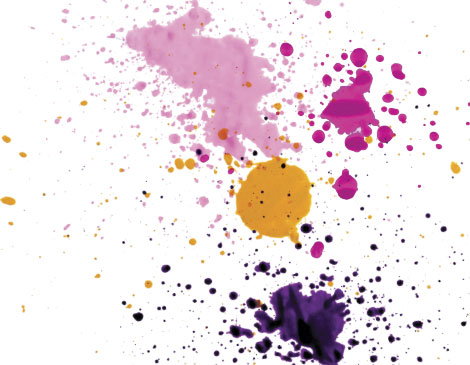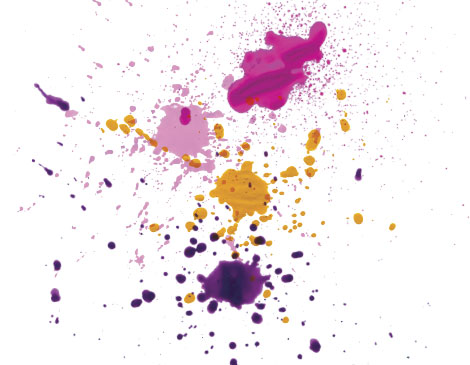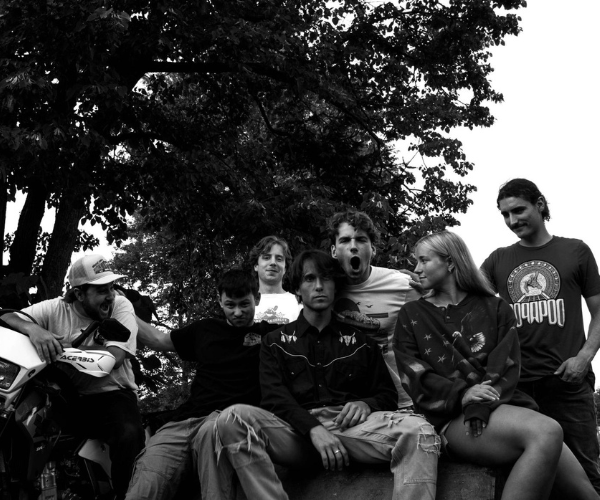The smooth soul-filled rhythm and blues tune is a take on what it feels like to run into a past lover and be forgotten. Brent Wesley and his eight-piece band recorded this 2016 track inside the mobile Jam in the Van studio. “The groove carries the whole song,” says Wesley. “Horns really solidify the identity of that song. They speak their own language and they can make a song sound happy or low-down and dirty.” We asked music composer and sound engineer Benjamin Smith to help us amplify the sound of each instrument during the chorus to see its impact on acrylic paint as a physical representation of the music. Here’s what we found.

VOCALS — MAGENTA
“His vocal style is very smooth and soulful. It’s powerful but it’s not overpowering to anything else at the same time, so it fits right in the middle of things,” says Smith. “The vocals were so smooth that the blobs weren’t really showing up as much, so I actually amplified it a little bit to show what it was really doing.”
HORNS — LIGHT PINK
“The horns were very sharp. When they came in, they made their presence felt,” Smith says. “They kind of hit the way a drum would. If you take the horns out of the song, you lose the richness. Horns are the icing on the cake. The cake is good by itself, but it can be kind of dry without the icing.”
GUITAR — ORANGE
“The guitar was very funky. It’s like the transmission of the car,” says Smith. “It has these different speeds to it, but at the same time, it’s all based off of the same drive. It’s as spread out as the bass, but it has a much smoother effect to it.”
BASS LINE — PURPLE
“It’s the wheels of the song, and everything else is able to move because of it. The way the paint is concentrated is indicative how important that bass line is,” says Smith. “It keeps the song grooving.”
“Hey Mama,” Samfox
After working for six months on what was meant to be a five-song EP, lead singer Braxton Taylor recorded this sex-charged romp of rhythm and blues in a single day, adding it as the final pivotal piece to The Feels. “The chorus is nontraditional. It doesn’t have a catchphrase or a hook,” says the 24-year-old frontman. “I wanted the riff and the horns to be what the focus was on. I wanted that music to be the part where everybody goes crazy.”

VOCALS — MAGENTA
“It looks like a nebula of sorts in the middle and then stars outside of it,” Smith says. “It’s the background vocals that make it spread out like that and add that special feel, while also having those concentrated main vocals in the center.”
DRUMS — LIGHT PINK
“The drums were hitting really hard in a concentrated manner. They were not as punchy as most songs are with hard-hitting drums, although they took up space very well,” Smith says. “They were more enveloping than normal drums are. The drums in this were more complementary to the instruments.”
GUITAR — ORANGE
“It didn’t have to be as dynamic, so it’s more of a sharp edge to the low-end rumble,” Smith says. “It’s almost like a helmet on a head or maybe the cover of a book. It’s not as sharp as other songs, but it’s not dull or round like the bass. It pulls with the bass perfectly.”
BASS LINE — PURPLE
“There’s an aggressiveness with the player. You kind of see that with the outside paint splashes. They’re headed out in almost every direction, kind of like an explosion,” says Smith. “It spread out more like a flower and that’s attributed to the more aggressive tone of the bass line.”
“Hendrick’s Ocean” by The Whiskey Hollow
This track has enough boot-stomping grit to take this smoky southern folk song to the top of your next playlist. An ode to an internal battle with mental health and alcoholism, lead singer Madeline Finn released the song on the band’s first EP X Waters in 2016. “The thing I love about that chorus the most is there’s a lot of ear candy and hidden things in there,” says 24-year-old Finn, who filled up liquor bottles with water for additional percussion on the last half of the chorus. “While you have the explosive bits in the bass and all that other stuff, you have these really light and kind of hidden parts of sound.”

VOCALS — MAGENTA
“She has a great range. She can not only hold out notes, but she can inject some vibrato with it as well and twist some notes. Even though the vocals are smooth and clear, there’s some grit and smokiness to it. The vocals were prominently featured on the song right smack in the middle. It was not to be contested with.”
DRUMS — LIGHT PINK
“I believe the drums were mixed flat to emphasize the guitar and the vocals more. It gave an old blues or old country acoustic rock feel to it like at a live show where there’s more of a foot stomp than a kick drum. This is another one we had to boost to get it to move like that. It was definitely a more supporting instrument than a leading instrument on this one.”
GUITAR — ORANGE
“It’s a very punchy guitar. It had a very commanding presence. The guitar was mixed very brightly. It stuck out in the song because there’s not a lot of instrumentation in this one, so each instrument kind of had room to have its own presence. The acoustic guitar here was much thicker than the other songs, but at the same time, it had its own range.”
BASS LINE — PURPLE
“There’s almost a call and response type feel to it. There’s this push and pull with the other instruments and it had a very magnetic feel to it."
BEHIND THE SCENES:
Art director Maria Amador loves when that bass drops, so she was inspired to mix her own creativity with that of the local musicians in our April cover package on page 82. With the help of music composer and sound engineer Benjamin Smith, Amador let the music’s vibrations paint a masterpiece. “Like the layered acetate depictions of the human body in a biology textbook, where one layer is the skeleton, one layer is the nervous system, I wanted to depict the inner workings of a song by layering the paint splatters it created,” says Amador. Laying a speaker on its back, the duo placed a piece of paper with a dab of paint on top. Smith then used audio repair program iZotope RX 6 to isolate and amplify the sound of each instrument for the chorus of each song. Played at a high volume, the music, bass grooves and drum kicks moved and shifted the paint. “We had to surgically go into it and discover where the frequencies were for each different instrument,” says Smith. “We’re using a flashlight to shine a light on where each instrument is sitting on your ears.” // Dillon Stewart



